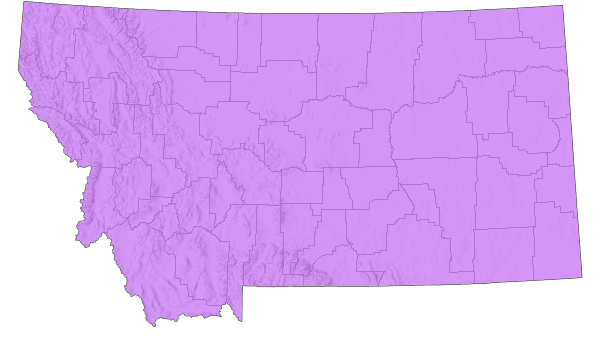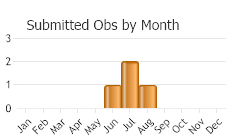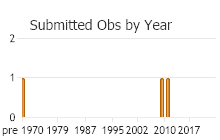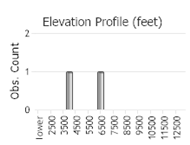View in other NatureServe Network Field Guides
NatureServe
Montana
Utah
Wyoming
Idaho
Wisconsin
British Columbia
South Carolina
Yukon
California
New York
Small Spot Snail - Punctum minutissimum
Other Names:
Punctum pygmaeum
General Description
A very small shell, to 1.5 mm diameter and usually 0.9 mm in height, flattened-heliciform with a low spire, with about 4 whorls. Shell is yellowish-brown, with a series of small closely-spaced axial riblets on both surfaces; periphery is rounded. The aperture is roundly crescent-shaped; umbilicus is somewhat narrow and deep, about 1/4 to 1/3 the shell diameter (Hendricks 2012, Burke 2013).
Diagnostic Characteristics
The spots are very small, yellowish brown shells (less than 3.0 mm diameter) with 4.0 to 4.25 whorls, which separates them from other species. Species of Pristiloma are more tightly coiled with more whorls, slightly larger in diameter with a narrow to absent umbilicus, and lack riblets. Punctum minutissimum is flatter in profile (lower conic) with a wider umbillicus than P. randolphi though similar in diameter, P. californicum is similar in shape to P. randolphi but larger with more solid riblets, Paralaoma caputspinulae is larger still (to > 2.0 mm diameter) with rather high cuticular riblets visible under magnification but with a flatter profile like P. californicum.
Species Range
Montana Range
Range Descriptions

 Native
Native
Range Comments
Mostly eastern Canada and the United States, but also to Alberta, Idaho, Oregon, Wyoming, Colorado, and New Mexico (Burke 2013). In Montana, reported on both sides of the Continental Dived from four counties: Lake, Park, Teton, Wibaux. Elevation range is 820 to 1975 m (2690 to 6480 ft). Range and abundance in Montana poorly defined; curent status needs investigation. Eleven live individuals were found at the Park County site in late August (Hendricks 2012).
Observations in Montana Natural Heritage Program Database
Number of Observations: 5
(Click on the following maps and charts to see full sized version)
Map Help and Descriptions
Relative Density

Recency



 (Observations spanning multiple months or years are excluded from time charts)
(Observations spanning multiple months or years are excluded from time charts)
Habitat
Forested sites near moisture. Canopy species include aspen and Douglas-fir. Found in moist sites under woody debris and in leaf litter or duff (Beetle 1961, 1989, 1997; Hendricks 2012). Habitat in Montana poorly documented.
Ecology
The species disappeared from aspen stands in Yellowstone National Park within six years following stand-replacement fires (Beetle 1997).
Stewardship Responsibility
References
- Literature Cited AboveLegend:
 View Online Publication
View Online Publication Beetle, D. E. 1961. Mollusca of the Big Horn Mountains. The Nautilus 74:95-102.
Beetle, D. E. 1961. Mollusca of the Big Horn Mountains. The Nautilus 74:95-102. Beetle, D.E. 1989. Checklist of recent Mollusca of Wyoming, U.S.A. The Great Basin Naturalist 49(4):637-645.
Beetle, D.E. 1989. Checklist of recent Mollusca of Wyoming, U.S.A. The Great Basin Naturalist 49(4):637-645. Beetle, D.E. 1997. Recolonization of burned aspen groves by land snails. Yellowstone Science 5 (summer):6-8.
Beetle, D.E. 1997. Recolonization of burned aspen groves by land snails. Yellowstone Science 5 (summer):6-8. Burke, T. E. 2013. Land snails and slugs of the Pacific Northwest. Corvallis, OR: Oregon State University Press. 344 p.
Burke, T. E. 2013. Land snails and slugs of the Pacific Northwest. Corvallis, OR: Oregon State University Press. 344 p. Hendricks, P. 2012. A Guide to the Land Snails and Slugs of Montana. A report to the U.S. Forest Service - Region 1. Montana Natural Heritage Program, Helena, MT. vii + 187 pp. plus appendices.
Hendricks, P. 2012. A Guide to the Land Snails and Slugs of Montana. A report to the U.S. Forest Service - Region 1. Montana Natural Heritage Program, Helena, MT. vii + 187 pp. plus appendices.
- Additional ReferencesLegend:
 View Online Publication
View Online Publication
Do you know of a citation we're missing? Henderson, J. 1924. Mollusca of Colorado, Utah, Montana, Idaho, and Wyoming. University of Colorado Studies 13(2):65-223.
Henderson, J. 1924. Mollusca of Colorado, Utah, Montana, Idaho, and Wyoming. University of Colorado Studies 13(2):65-223. Pilsbry, H.A. 1948. Land Mollusca of North America (north of Mexico), Volume II Part 2. The Academy of Natural Sciences of Philadelphia Monograph Number 2(2): 521-1113.
Pilsbry, H.A. 1948. Land Mollusca of North America (north of Mexico), Volume II Part 2. The Academy of Natural Sciences of Philadelphia Monograph Number 2(2): 521-1113. Squyer, H. 1894. List of shells from the vicinity of Mingusville, Montana. The Nautilus 8:63-65.
Squyer, H. 1894. List of shells from the vicinity of Mingusville, Montana. The Nautilus 8:63-65. Van Es, J. and D.A. Boag. 1981. Terrestrial molluscs of central Alberta. Canadian Field-Naturalist 95(1): 75-79.
Van Es, J. and D.A. Boag. 1981. Terrestrial molluscs of central Alberta. Canadian Field-Naturalist 95(1): 75-79.
- Web Search Engines for Articles on "Small Spot Snail"
- Additional Sources of Information Related to "Snails / Slugs"





